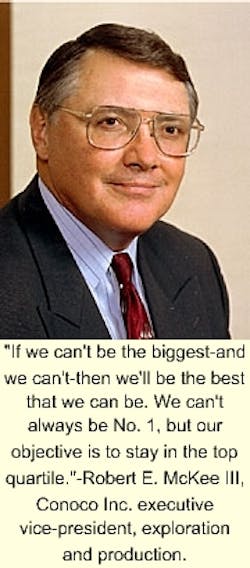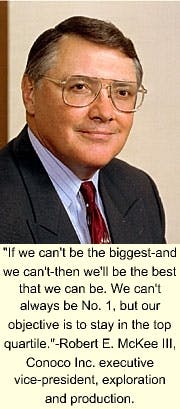COMPANY NEWS: Integrated company ranking confirms Conoco's E&P revitalization
Houston integrated energy company Conoco Inc. steps into this week's company news limelight by being ranked first in exploration and production results in a comparative-performance analysis of 13 major integrated companies by Prudential Securities Inc. for 1995-99.
Meanwhile, two Canadian firms-Anadarko Canada Corp. and Alberta Energy Co. Ltd.-have struck a complex farm-out deal. The exchange is expected to provide the two firms with a more diverse asset portfolio in the Mackenzie Delta region of the Canadian Arctic-a region expected to be key to supplying North American markets with much-needed natural gas.
Conoco on top
Late last month, Conoco was revealed as the top-ranking exploration and production company among 13 of its peers by Prudential Securities Inc. It was the second consecutive win for the company, which placed first in an identical 1998 study by Schroder & Co., company officials said.
The Prudential study ranked Conoco in the highest tiers for:
- Production income, along with BP Amoco PLC (now BP) and TotalFina SA (now TotalFinaElf SA).
- Quality of earnings, along with ExxonMobil Corp., Amerada Hess Corp., and Unocal Corp.
- Cash flow, along with Amerada Hess.
- Production replacement ratios, along with Royal Dutch/Shell Group and TotalFinaElf.
- Upstream returns, along with Shell.
Prudential officials also rated Conoco above-average for finding and development costs, including acquisitions and divestments. In that category, Conoco was behind BP, Shell, Texaco Inc., and the former Elf Aquitaine SA, but on a par with TotalFina and ExxonMobil (see table). Conoco ranked average for the group in the categories of adjusted production; depreciation, depletion, and amortization expenses; and discounted future net cash flow.
"If we can't be the biggest-and we can't-then we'll be the best that we can be. We can't always be No. 1, but our objective is to stay in the top quartile," said Robert E. (Rob) McKee III, Conoco's executive vice-president, exploration and production.
"We started from the tail end of the pack 5-6 years ago, and we said we were going to manage this business back to health," he told reporters during a Houston press conference Aug. 29.
Under McKee's direction, Conoco has reduced its number of producing fields by 65% and cut its upstream overhead and operating costs by about 20% since 1992. During the same period, the company has increased its total reserves by 53% and boosted production 19% from operations in the US Gulf of Mexico, the UK North Sea, Venezuela, Viet Nam, Canada, and Russia. At the end of 1999, its global proved reserves totaled 2.6 billion boe, with total production of 636,000 boe/d.
Conoco's drilling success rate also has improved to 50% of the 20 wildcat wells it drilled last year, primarily in its target areas of the deepwater gulf, the North Sea, and Indonesia, up from a 30% success rate in 1998. The company has slashed its finding and development costs by 36% to a 5-year average of less than $4.50/boe in 1999, from a 1998 5-year average of $7/boe.
As a result, Conoco's upstream operations earned a record $845 million before special items last year.
Conoco's rise
McKee credits Conoco's team approach for that success, including the upstream finding team that he formed to evaluate all exploration options and allocate resources with a global perspective in place of the regional approach the company employed in the past.
"We're pretty proud of our capital spending discipline. We have to spend money to grow, but we watch that closely," McKee said.
International upstream operations will get more of Conoco's capital in the future, he said. One country that McKee hopes to re-enter soon is Libya. Conoco had a 40% interest in the old Oasis group of US producers, including Marathon Oil Co. and Amerada Hess, that were operating in Libya before 1986 when the US government imposed a raft of trade sanctions that forced their withdrawal.
Libya's National Oil Co. has since changed the Oasis name to Waha Oil Co. and has taken over the operation of those oil fields, marketing the US companies' share of production on its own account (OGJ, June 18, 1990, p. 23). "But we kept the right to come back and reenter the country once the political dispute is settled," said McKee.
He thinks a political reconciliation may come soon, now that Libya has met some of the US demands by turning over suspected terrorists for trial in an international court. The move toward normalizing US relations with Libya is on track, regardless of who is elected president this fall, he said.
Conoco officials have since been back to Libya, with the US government's blessing, to look at those properties and to talk with Libyan officials about eventually resuming operations there. "One team returned about a week ago," McKee said at the press conference.
The former Oasis fields are still producing about 300,000 b/d, with the possibility of being increased to more than 400,000 b/d, he said. "They need our expertise and our investment," McKee said.
International oil companies voted Libya as their top choice area for new exploration, development, and production ventures this year in a recent survey by Robertson Research International Ltd. (OGJ Online, May 24, 2000). The changing political environment and prospects for world-class production plays vaulted Libya to the top spot from 20th position in Robertson's previous survey in 1998.
That same poll picked Iran as the second most attractive country for E&P opportunities. An earlier deal by Conoco to develop Iran's offshore Sirri field was torpedoed by Pres. Bill Clinton in a political move that allowed TotalFinaElf predecessor Total SA to step in (OGJ, Oct. 6, 1997, p. 31). However, McKee said, "We have kept up a constant dialogue with the Iranians. They have told us that, when it's okay for us to come back, they'll talk seriously with us about new opportunities there."
He said, "Up until 2 years ago, 90% of our earnings and 75% of our production came from North America and Northwest Europe. But we knew we didn't have the growth opportunities we needed in those two core areas."
Venezuela "undoubtedly" will be Conoco's third area of core operations, said McKee, with Southeast Asia "likely" to emerge as the fourth.
Beyond that, the company is looking to develop opportunities in Russia, Nigeria, and the Middle East. Conoco Energy Nigeria is negotiating to participate in development of two oil fields in the Niger Delta (OGJ Online, Aug. 17, 2000).
"Nigeria is still a region where you've got to watch your P's and Q's, but there has been a sea change of difference with the new regime there. They're really trying to change that culture," said McKee.
Conoco also plans to use the expertise that it has quietly acquired in gas-to-liquids (GTL) technology as a key to enter new markets (OGJ Online, June 28, 2000). Although the company has "no significant stranded gas reserves at the moment," McKee said its GTL capabilities are part of ongoing negotiations in several countries, including Russia, Algeria, Nigeria, and Venezuela.
He offered a "guesstimation" that the technology is only "a couple of years away" from the effective cost levels required for commercial operation. Conoco is likely to license that technology, McKee said.
Anadarko deal
Anadarko Canada and AEC have struck a complex deal in which AEC has farmed out to Anadarko a portion of its interest in two licenses in the Mackenzie Delta region of the Canadian Arctic, and Anadarko has agreed to farm out to AEC part of its stake in some Alaskan North Slope acreage.
Anadarko Canada, a unit of Anadarko Petroleum Corp., Houston, is expanding its Canadian holdings by purchasing from AEC, Calgary, interests in two exploration licenses in the hydrocarbon-rich MacKenzie Delta basin region of Canada's Northwest Territories. The price paid for the 37.5% interest in two exploration licenses covering 530,000 acres was not disclosed.
"Increasing our Canadian holdings in the MacKenzie Delta fits our long-term strategy of providing natural gas to North American markets," said Robert J. Allison Jr., Anadarko chairman and CEO. "We believe arctic gas will find its way to Canadian and American consumers through one or more of the pipelines being proposed from Canada and Alaska."
Because Anadarko also holds a significant acreage position on the Alaska North Slope, this purchase puts the company in a better position to have gas available for delivery into whatever pipeline is ultimately built, whether from Alaska or Canada or both, Allison added.
The MacKenzie Delta acquisition consists of stakes in two onshore blocks adjacent to the natural gas-rich Parsons Lake field. AEC will retain a 37.5% interest and continue serving as operator; Gulf Canada owns the remaining 25%.
The purchase augments Anadarko's previous Canadian Arctic holdings. These consist of nonoperated working interests ranging from 3.4% to 24% in 10 significant discovery licenses and one production license, which, combined, cover more than 142,000 acres. This acreage includes the Amauligak field, the largest offshore field in the Canadian portion of the Beaufort Sea, says Anadarko.
Anadarko Canada recently submitted a successful bid for an exploration license on one of the MacKenzie Delta-Beaufort Sea tracts offered in the Aug. 14 lease sale by the Minister of Indian Affairs and Northern Development. Anadarko acquired a 100% working interest in Exploration License No. 407, which is centrally located in a region where 53 fields with reserves of 9 tcf of gas and 1 billion bbl of oil already have been discovered, says the firm.
The license covers about 176,000 acres and is immediately northwest of the giant Taglu field and near the AEC-Anadarko MacKenzie blocks.
AEC acquisition
In a separate deal, AEC subsidiary AEC Oil & Gas (USA) Inc. is buying from Anadarko a 33.33% working interest in Alaska North Slope acreage held under exclusive lease option by Anadarko. The lease covers 3.1 million acres under option from the Arctic Slope Regional Corp. in the Foothills region south of Prudhoe Bay. The purchase price was not disclosed. Anadarko will remain as operator, retaining a 66.67% working interest.
"This exchange of interests with Anadarko, combined with our recently announced world-class oil exploration opportunities in northern Alaska, has the potential to establish this region as a new growth platform for AEC," said AEC Pres. and CEO Gwyn Morgan, referring to a North Slope exploration and development alliance formed by AEC, Phillips Petroleum Corp., and Chevron Corp. (OGJ Online, Aug. 4, 2000). "These basins have been recognized as having world-scale resource potential with exploration opportunities that will fuel our progress toward our goal of being a global 'superindependent' oil and gas company."
Undiscovered reserves for onshore Mackenzie Delta and Alaskan foothills are estimated by government agencies at up to 40 tcf. Active gas exploration programs in both areas provide AEC with the potential to supply significant long-term gas volumes from the Northern frontiers into the North American gas market. AEC said it stands to benefit from operations in both hydrocarbon regions, regardless of whether Canadian or Alaskan gas moves to markets first.


